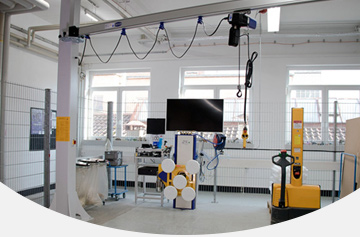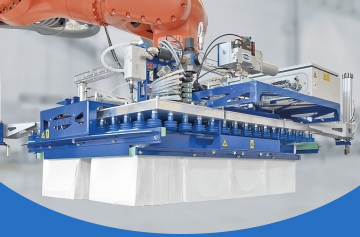

When it comes to lifting heavy loads, having the right equipment is crucial. Whether you’re in a warehouse, construction site or manufacturing facility, effective lifting solutions can make all the difference. Lifting equipment not only helps you move items safely but also boosts productivity and efficiency on the job.
From vacuum gripping systems to full crane systems, there’s a vast array of options available on the market today. Selecting the appropriate tools for your specific needs can seem overwhelming at first glance. However, understanding what types are out there and what factors to consider will empower you to make informed decisions that enhance safety and streamline operations.
The Importance of Choosing the Right Lifting Equipment
Choosing the right lifting equipment is crucial for any operation. It directly impacts efficiency and productivity. Using inappropriate tools can lead to delays and increased costs.
Selecting the correct lifting solution also enhances safety in the workplace. Mismatched equipment increases the risk of accidents, which can have serious consequences for both workers and employers.
Additionally, investing in quality lifting gear promotes durability and reliability. This reduces maintenance needs over time, allowing teams to focus on their tasks rather than repairs.
Types of Lifting Equipment
When considering lifting equipment, the options are vast. From vacuum gripping systems to full crane setups, there’s something for every need.
Forklifts are common in warehouses and construction sites. They excel at moving heavy objects quickly and efficiently.
For more specialised tasks, hoists come into play. These devices lift items vertically, often used in maintenance and repair applications.
Crane systems offer versatility with their ability to reach high areas or span large distances. They can handle substantial weights with precision. Gantry cranes and Jib Cranes can offer superb solutions, offering great versatility alongside performance.
Manual handling tools shouldn’t be overlooked either. Trolleys and pallet jacks make transporting goods easier without mechanical assistance.
Each type serves a unique purpose while promoting increased efficiency in operations across various industries. The right choice enhances productivity and safety on any job site.
Factors to Consider When Choosing Lifting Equipment
When selecting lifting equipment, the load capacity tops the list. Ensure that the chosen equipment can handle the maximum weight you intend to lift.
Next, assess your workspace. The dimensions and layout will influence which type of equipment fits best. Consider height restrictions and any obstacles in your environment.
Think about frequency of use. If you’re lifting regularly, investing in more durable machinery could save time and cost in repairs down the line.
Evaluate ease of operation as well. Equipment should be user-friendly to minimise training time for staff while maximising productivity.
Check compliance with safety standards and regulations specific to your industry. This ensures not just efficiency but also protects workers from potential hazards associated with improper lifting practices.
Benefits of Using Lifting Equipment
Lifting equipment plays a crucial role in various industries by streamlining operations. The use of this equipment can lead to increased efficiency, allowing tasks to be completed quickly and accurately.
One significant advantage is the reduced physical strain on workers. This not only improves productivity but also contributes to better overall workplace morale.
Safety is another benefit that cannot be overlooked. Proper lifting equipment reduces the risk of injuries caused by manual handling, creating a safer environment for everyone involved.
Additionally, investing in quality lifting solutions often leads to cost savings over time. Businesses can avoid expenses related to accidents or damaged goods.
Moreover, specialised options like vacuum gripping systems provide versatility and adaptability for unique lifting challenges, ensuring that companies have tailored solutions at their disposal.
Safety Tips for Using Lifting Equipment
Safety should always be a top priority when using lifting equipment. Before starting any task, ensure that all operators are trained and familiar with the equipment’s operation.
Always inspect your lifting gear before use. Look for signs of wear, damage, or malfunction. A quick check can prevent accidents and ensure everything functions smoothly.
When operating cranes or other heavy machinery, maintain clear communication with your team. Use hand signals or radios to avoid misunderstandings while moving loads.
Keep the work area tidy and free from obstructions. This reduces risks and allows for safe maneuverability around the lifting equipment.
Never exceed weight limits specified by manufacturers. Respecting these guidelines protects both personnel and equipment from potential risks associated with overloading. Emphasizing safety fosters a more productive environment in which everyone can perform their tasks confidently.
Maintenance and Care for Your Lifting Equipment
Regular maintenance is crucial for the longevity of your lifting equipment. Establish a routine inspection schedule to catch any wear and tear before it escalates into significant issues.
Check all components, including cables, hooks and hydraulic systems. Look for signs of corrosion or damage that could compromise safety.
Lubrication plays a vital role too. Ensure moving parts are well-greased to prevent friction-related problems. This simple step can increase efficiency and prolong lifespan.
Keep an eye on load limits as well. Overloading can lead to mechanical failure, endangering both operators and goods.
Training staff on proper usage also enhances care practices. Knowledgeable operators will treat equipment with respect and follow best practices diligently.
Maintain detailed records of inspections, repairs and any incidents. These logs provide insight into performance over time and help inform future decisions about upgrades or replacements.
Making the Right Choice
Choosing the right lifting equipment is crucial for efficiency and safety in any workplace. With various options available, it’s essential to assess your specific needs. Consider factors such as load capacity, operating environment and the frequency of use.
Selecting appropriate equipment can lead to increased efficiency and improved safety standards on-site. The numerous benefits of using well-suited lifting devices cannot be overstated; they not only streamline operations but also lessen risks associated with manual handling.
Regular maintenance and care are vital in prolonging the life of your lifting gear. By adhering to manufacturer guidelines and conducting routine checks, you ensure reliability when it matters most.
Making an informed decision about lifting equipment will contribute significantly to a safer work environment while enhancing productivity levels across your organisation. Be sure to explore all options available through Turbo Vacuumentation Limited for tailored solutions that fit your operational requirements perfectly.

